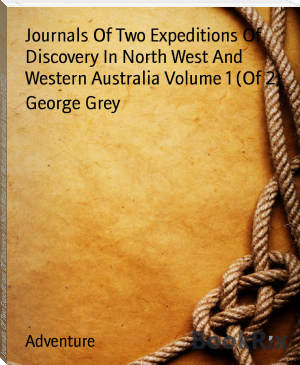Journals Of Two Expeditions Of Discovery In North West And Western Australia Volume 1 (Of 2), George Grey [robert munsch read aloud txt] 📗

- Author: George Grey
Book online «Journals Of Two Expeditions Of Discovery In North West And Western Australia Volume 1 (Of 2), George Grey [robert munsch read aloud txt] 📗». Author George Grey
End Of Five Days Dig It Up Again And Wrap Up The Bones, Etc., In Bark Of
Trees, And Carry Them Along With Them. When The Women Fight, Which Is
Very Often, They Use A Short Kind Of Club. The Natives Paint Their Bodies
Over With Red Clay To Prevent The Mosquitoes From Biting Them. When They
Paint Their Bodies White It Is A Sign Of War With Some Other Tribe.
...
A Very Remarkable Instance Of Coincidence In This Custom With Regard To
The Dead Will Be Found In A Subjoined Extract From A Letter Sent To Me By
An Officer Of The Beagle, Together With A Skeleton Which He Had Found At
Cygnet Bay. The Skeleton Has Been Presented To The Royal College Of
Surgeons:
Volume 1 Chapter 11 (Natural History Climate Aborigines) Pg 159The Skeleton Was Found Enveloped In Three Pieces Of Papyrus Bark, On A
Small Sandy Point In Cygnet Bay. All The Bones Were Closely Packed
Together, And The Head Surmounted The Whole. It Did Not Appear To Have
Been Long Interred. They Had Evidently Been Packed With Care. All The
Long Bones Were Undermost, And The Small Ones Were Strewed In Among Them.
The Head Was Resting On Its Base, Face Across.
Three Natives Were Close To The Place When We First Landed: The Eldest Of
The Party Went Up To The Spot Immediately After I Had Removed The Bones;
He Turned Up The Bark With His Foot, And Did Not Appear To Show The
Slightest Symptom Of Uneasiness. They Were For Some Days Among The
Watering Party On Very Friendly Terms.
...
Caves. Drawings. Tombs.
As I Never, During My Subsequent Travels In Australia, Saw Anything At
All Resembling The Painted Caves Which I Have Described In The Ninth
Chapter, I Shall Here Add Some Observations On The Subject, Which I Could
Not Have There Detailed Without Too Great An Interruption To The
Narrative.
Two Other Instances Of Australian Caves Which Contain Paintings Have Been
Recorded. The First Is By Captain Flinders And The Second By Mr.
Cunningham In King's Voyage.
Paintings At Chasm Island.
The Caves Found By Flinders Were In Chasm Island, In The Gulf Of
Carpentaria, And Are Thus Described:*
In The Steep Sides Of The Chasms Were Deep Holes Or Caverns Undermining
The Cliffs; Upon The Walls Of Which I Found Rude Drawings, Made With
Charcoal, And Something Like Red Paint, Upon The White Ground Of The
Rock. These Drawings Represented Porpoises, Turtles, Kangaroos, And A
Human Hand; And Mr. Westall, Who Went Afterwards To See Them, Found The
Representation Of A Kangaroo, With A File Of Thirty-Two Persons Following
After It. The Third Person Of The Band Was Twice The Height Of The
Others, And Held In His Hand Something Resembling The Waddy Or Wooden
Sword Of The Natives Of Port Jackson
Paintings At Clack's Island.
The Second Instance Is Taken From Mr. Cunningham's Manuscripts And Is
Volume 1 Chapter 11 (Footnote) Pg 160(*Footnote. Flinders' Voyages Volume 2 Page 158.)
(*Footnote. North-East Coast Of Australia.)
Volume 1 Chapter 11 (Natural History Climate Aborigines) Pg 161Contained In The Following Extract:*
The South And South-Eastern Extremes Of Clack's Island Presented A Steep,
Rocky Bluff, Thinly Covered With Small Trees. I Ascended The Steep Head,
Which Rose To An Elevation Of A Hundred And Eighty Feet Above The Sea.
The Remarkable Structure Of The Geological Features Of This Islet Led Me
To Examine The South-East Part, Which Was The Most Exposed To The
Weather, And Where The Disposition Of The Strata Was Of Course More
Plainly Developed. The Base Is A Coarse, Granular, Siliceous Sandstone,
In Which Large Pebbles Of Quartz And Jasper Are Imbedded: This Stratum
Continues For Sixteen To Twenty Feet Above The Water: For The Next Ten
Feet There Is A Horizontal Stratum Of Black Schistose Rock Which Was Of
So Soft A Consistence That The Weather Had Excavated Several Tiers Of
Galleries; Upon The Roof And Sides Of Which Some Curious Drawings Were
Observed, Which Deserve To Be Particularly Described. They Were Executed
On A Ground Of Red Ochre (Rubbed On The Black Schistus) And Were
Delineated By Dots Of A White Argillaceous Earth, Which Had Been Worked
Up Into A Paste. They Represented Tolerable Figures Of Sharks, Porpoises,
Turtles, Lizards (Of Which I Saw Several Small Ones Among The Rocks)
Trepang, Starfish, Clubs, Canoes, Water Gourds, And Some Quadrupeds,
Which Were Probably Intended To Represent Kangaroos And Dogs. The
Figures, Besides Being Outlined By The Dots, Were Decorated All Over With
The Same Pigment In Dotted Transverse Belts. Tracing A Gallery Round To
Windward, It Brought Me To A Commodious Cave Or Recess, Overhung By A
Portion Of The Schistus, Sufficiently Large To Shelter Twenty Natives
Whose Recent Fire Places Appeared On The Projecting Area Of The Cave.
Many Turtles' Heads Were Placed On The Shelves Or Niches Of The
Excavation, Amply Demonstrative Of The Luxurious And Profuse Mode Of Life
These Outcasts Of Society Had, At A Period Rather Recently, Followed. The
Roof And Sides Of This Snug Retreat Were Also Entirely Covered With The
Uncouth Figures I Have Already Described.
As This Is The First Specimen Of Australian Taste In The Fine Arts That
We Have Detected In These Voyages It Became Me To Make A Particular
Observation Thereon: Captain Flinders Had Discovered Figures On Chasm
Island, In The Gulf Of Carpentaria, Formed With A Burnt Stick; But This
Performance, Exceeding A Hundred And Fifty Figures, Which Must Have
Occupied Much Time, Appears At Least To Be One Step Nearer Refinement
Than Those Simply Executed With A Piece Of Charred Wood. Immediately
Above This Schistose Is A Superincumbent Mass Of Sandstone Which Appeared
To Form The Upper Structure Of The Island.
Paintings In The York District.
Volume 1 Chapter 11 (Footnote) Pg 162(*Footnote. King's Australia Volume 2 Page 25.)
Volume 1 Chapter 11 (Natural History Climate Aborigines) Pg 163There Is A Third Instance Of A Cave With A Figure In It In The District
Of York, In The Settlement Of Swan River; But In This Case The Species Of
Circle Which Is Drawn On The Cave, Or Rather Scraped Into It With A Piece
Of Stone, May Represent Anything Or Nothing; In Fact It Is No More Than
Any Idle Or Thoughtless Savage Might Have Executed, Without Any Fixed
Design Whatever. The Only Other Vestige Of Drawing Contained In The Cave
Is Evidently The Mere Impression Of A Hand, Which Has Been Rubbed Over
With The Red Paint With Which The Natives Are In The Constant Habit Of
Bedaubing Themselves, And Has Then Been Pressed In On The Wall.
Native Traditions.
I Had Been Told That The Natives Had Some Very Curious Traditions Current
Amongst Them With Regard To This Last Cave And, After Having Visited It
And Satisfied Myself That There Was No Analogy Between It And The Caves
On The North-West Continent Of Australia, I Set About Collecting Some Of
The Native Stories That Related To It. These Legends Nearly All Agreed In
One Point, That Originally The Moon, Who Was A Man, Had Lived There; But
Beyond This There Was Nothing Common To Them All, For Every Narrator
Indulged His Own Powers Of Invention To The Greatest Possible Degree,
Scarcely Ever Relating The Same Story Twice, But On Each Occasion
Inventing A New Tradition; And The Amount Of Marvels And Wonders Which He
Unfolded In This Revelation Were Exactly Proportioned To The Quantity Of
Food Which I Promised To Give Him. I Once Or Twice Charged Them With
Attempting To Impose Upon My Credulity And, Far From Denying The Charge,
They Only Laughed And Said, "That Was A Very Good Thing Which They Told
Me, And That The Djanga (White Men) Liked It Very Much."
Colours Used In Painting.
In The Painted Caves On The North-Western Coasts Five Colours Were Used:
Red, Several Shades; Yellow; Blue; Black, And White. With The Exception
Of Blue These Colours Are All Known To The Natives Of The Whole
Continent. The Red They Either Dig Up From The Earth, Fit For Use, In The
Form Of Red Earthy Pebbles, Or They Find It In The Form Of A Brilliant
Yellow Clay, Which They Beat, Clean, And Dry, Leaving It Exposed To The
Air For Several Days, When They Bake It In A Bark Basket, And Then, If
The Clay Is Good And It Has Been Well Prepared And Burnt, It Is Nearly As
Bright As Vermilion. In Some Parts Of The Continent However No Good Clay
Can Be Found; And In This Case, At Their Annual Fair, Where They Meet To
Exchange Certain Commodities Only Locally Produced, This Brilliant Red
Ochre Is Considered A Very Valuable Article Of Traffic.
Yellow They Obtain From Several Sources: The Most Common Is The Yellow
Clay From Which The Red Is Afterwards Produced, But They Also Procure It
From A Stone Which Is Traversed By Veins Of Yellow Earth; From The
Interior Of The Nest Of A Species Of Ant Which Collects





Comments (0)